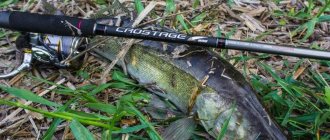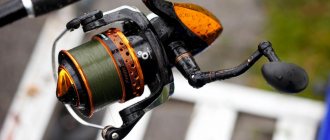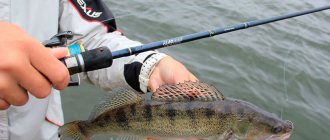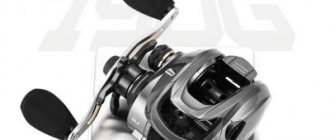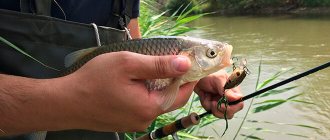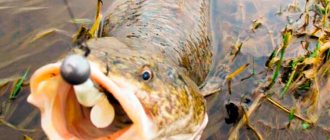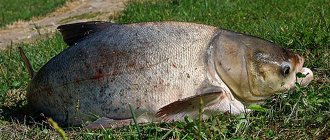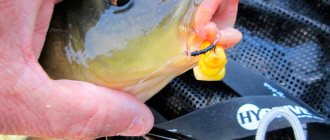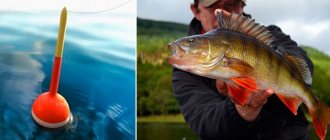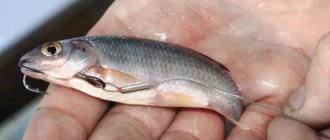You can assemble a spinning rod for pike using two radically different approaches. By contacting a salesperson at a fishing store or using your own knowledge and experience.
The first option has one undoubted advantage - in fact, you don’t need to know anything, the consultant will tell you everything and do it for you. This is where the advantages end.
There are a lot of disadvantages:
- from experience - often sales people hire people who don’t even know how a spinning rod differs from, for example, a fly fishing rod;
- the merchant’s task is to warm you up with everything, to sell you what is stale and what is more expensive;
- only you can know what exactly you need: how often you will fish, fishing locations and conditions, preferred methods of hunting for predatory fish, and other aspects.
And the main thing!
The process of independently assembling a spinning rod - selecting a rod, and a reel and cord for it, followed by balancing, choosing the right accessories and leashes, baits and other equipment brings no less pleasure to a real spinning angler than the process of hunting on the mirror surface of a lake or river. You need to understand that the configuration and equipment of spinning tackle for pike is not an idle question, and with an inept approach to choosing and equipping a fishing rod, fishing will bring nothing but disappointment. For this reason, we recommend that you carefully select all components.
Mounting options
Mounting a wobbler on a spinning rod must ensure the articulation of the connection in order to give the bait proper play. If we catch pike, protect it from cutting. When twitching on a soft leash, the front tee overlaps the leash if it is soft. Therefore, rigidity is added to the criteria. The correct hard leash on a jerk is pulled to the side like a lever, and the hooks simply do not reach it.
Depending on the situation, you can tie a wobbler correctly using several methods:
- Large and medium-sized minnows and shads for pike – only twisted string or thick fluorocarbon.
- Cranks that do not require jerking wiring - you can use a regular soft metal leash.
- If there is no pike, you can attach the wobbler directly to the braid.
- Small wobblers and their buoyancy are affected by the weight of the leash and accessories.
Let us examine in more detail the nuances of how to attach a wobbler depending on these conditions. All this information applies to poppers, walkers, and ratlins.
String twist
Pike are present almost everywhere in our reservoirs. Even when hunting chub with small surface cranks, it is likely that he will take a pencil and cut the braid. Therefore, in our conditions, it is advisable to use metal leashes with wobblers. Except for rare cases when the pike in this particular place definitely does not take. To the question of which leashes are best for wobblers in our conditions, there is only one answer - a twisted metal string in most cases. Firstly, it protects the cord from pike teeth. Secondly, the rigidity of the string prevents the tee from overlapping the fishing line.
Wobblers are expensive baits, and their loss is costly. However, if the weight of the leader has almost no effect on the performance of large wobblers for pike, then on small ones it can significantly change the buoyancy. A floating microcrank or small minnow can turn into a sinking one - here we are already working on the issue of loading.
Factory ring
The winding ring is removed when using the leash - in this case, this element of the fittings becomes an extra link in the equipment. The ring is left if the wobbler is tied with a blind knot to braiding or fluor – to maintain mobility. It should be left if the bait ring is placed deep in the recess of the blade (on some models), and it is difficult to attach a leash to it, since the twist or carabiner does not fit into it because of this.
Twist
The string leash for wobblers is made of stainless steel wire or string with a diameter of 0.28-0.4 mm. The thicker and longer, the heavier. On large pike and large minnows you can use powerful and long twists, up to 30 cm long. With small baits we select them so that the leash does not change its buoyancy much. By selecting the weight of the leash, leaving or removing the winding ring, knotless, swivel at the other end, we achieve the desired buoyancy.
Ready-made twists - in any fishing stores, with or without swivels. You can twist them yourself with a screwdriver or a special machine. For example, from the Ramenskaya Stringa company - on the website there are ready-made leashes, as well as a machine and a supply of wire with a diameter of 0.3 and 0.4 mm. We are looking for or making twists with a wide eye, 5-7 mm in diameter - this is better for articulation at the junction.
If the spinner fishes not only with wobblers, then it is also easy to attach a spinner or jig equipment to the twist when changing the bait. String leads are a consumable item, so you need to have a certain supply. During intensive fishing, they bend or break and must be replaced. Light curvatures can be straightened carefully by pulling along the nail.
The bait is simply installed at one end of the twist. For beginners, after using fasteners on spinners, it seems inconvenient to unwind and roll back the twist every time when replacing baits. However, after a couple of fishing trips it becomes a habit and does not cause any difficulties. On the other hand, accordingly, the twist is attached to the cord by tying, or through a knotless or swivel.
Swivel
Another question is whether a swivel is needed for a wobbler. If spinners are not used, then no. The cord can be woven into the twist itself, or fastened with a knotless connection into a special fastener (more on this later). The presence or absence of a swivel is not critical for large minnows. But when working with small baits, the weight of the swivel affects the load and buoyancy.
Knot to swivel
If a swivel is installed on the string, you can attach the wobbler to the spinning rod with any knot, like a regular soft metal leash for a pike. There are three reliable and proven nodes; there is no need to reinvent the wheel. We don’t use a regular shark knot (fisherman’s loop) - on slippery braid, especially with constant twitching jerks, it can weaken and come undone. We use any of the following, no matter:
- Palomar (the most reliable option for a swivel).
- Improved (locked) or double locked clinch, trailin.
- The loop-to-loop method based on a figure of eight is convenient for quickly replacing leashes.
However, it is still better to tie the knot every time, especially during intensive fishing for large pike or when using Chinese braid. Especially when twitching large minnows that create a constant jerk load. When rigging a spinning rod with a wobbler, you need to constantly monitor the quality of the anchor point and the lower end of the cord - cut off wear in a timely manner and update the knot.
Knotless twist weaving
A string without a swivel can be attached to the cord by simply tying it into the top twist. The spiral unwinds halfway. The cord is threaded through the eye, wrapped around the leash and brought back out, the twist is put into place. A reliable and simple method of fastening - more tensile strength than any knots. In this way, it is recommended to attach the wobbler to the string leash if the presence of a knotless fastener or swivel critically affects the buoyancy of the bait.
Knotless clasp
The best way to mount a wobbler on a spinning rod to a string is through a special knotless fastener. The knotless connection is wound onto a specially designed carabiner. This method is more reliable than weaving, since the fastener wire is much thicker than the one from which the leash is made.
Knotless sometimes catches filamentous green mud on itself - we periodically pay attention to this and clean it. However, this is still the most reliable and strong connection.
How to attach a wobbler to a string leader using a knotless fastener:
Bait selection
Most often used for pike fishing:
- spinners;
- oscillating spoons;
- silicone baits;
- wobblers.
Spinning rods are best suited for catching pike with a spinning rod in the coastal zone at shallow depths. They perfectly attract predators of any size. Models axle loading deep areas , including currents. Such fishing, as a rule, takes place from a boat, since rotating spoons have poor flight qualities and it is impossible to cast them far.
Oscillating spoons have remained one of the most popular lures for pike fishing for several decades. They can be used for fishing from the shore and from a boat in shallows, medium and deep depths, selecting models that are suitable in weight. An important advantage of oscillators is that they have excellent flight qualities.
Silicone fish on jig heads or spaced rigs are the best option for fishing in great depths. They are affordable, easy to use and still produce great catches. You can catch pike in the coastal zone with unloaded tires.
Wobblers are universal baits that can be used at shallow, medium and deep depths in currents and in still water, choosing a model that is suitable in size, weight, buoyancy and depth level. But fishing with them requires a certain level of technical skill, so they are not suitable for beginners.
Regular leashes
A common mistake made by beginner wobbler operators is to hang the wobbler on a soft leash and twitch. In this case, the tee overlaps, and the bait, naturally, does not work on the retrieve. However, the use of conventional multi-strands is acceptable:
- When fishing with cranks evenly, without twitching, or when trolling.
- When twitching with specific models of baits, when overlap simply does not occur.
If the kit contains a lot of wobblers specifically for twitch, you need rigidity. A better leash for a wobbler than a twist has not yet been invented. Some anglers use hard, thick fluorocarbon about 0.8 mm, which also does not cause overlap. However, such a leash needs to be changed after fishing - due to microdamages, it may not withstand the next attack of the toothy one. Good fluorocarbon, moreover, is not cheap, and leashes made from it are consumable. For beginners, it’s better not to worry about this, but to equip a wobbler on a spinning rod through a metal twist.
How to properly wind fishing line or cord on a spinning reel
Before you get ready to wind fishing line or braided cord onto a reel, you need to decide what type of laying you need. This choice determines such parameters as: the probability of loops being dropped (the cause of the “beard”) and the maximum possible casting distance. It just so happens that there are only three types, so I suggest you pay attention to each one.
Reverse cone cord laying
They say that this method of laying has recently been considered the most common among experienced spinning players. Whether this is true or not, we will see in the reservoirs, but this form of styling should be given its due, the likelihood of a beard actually decreasing. And we will have to pay for such luxury in terms of casting range. If the reel is not cheap, then thanks to the high-quality polished spool and other technologies that the reel is stuffed with, the fee will not be so high.
This effect is achieved by reducing the winding pitch to the side of the spool. Pay attention to the photo. You've probably seen this form before.
Laying the cord in a “simple cone”
In the previous case, we reduced the likelihood of a beard and sacrificed casting distance. And now we will do everything exactly the opposite. With this installation, when the winding pitch increases from the top edge of the spool to the base, our cast in theory can be further by 15%; of course, these are approximate calculations. And, perhaps, it is possible to comfortably use such an advantage only in the case of ideal winding, and when other requirements are met that minimize the possibility of loops being reset.
“Cylindrical” cord laying
When purchasing a new reel from the factory, most likely it will be configured specifically for a cylindrical shape, i.e. straight, with a uniform step from the top edge of the spool to its base. Perhaps this is an excellent compromise between casting range and the ability to “catch a beard”. I don’t know why many people write that the “reverse cone” is considered the most popular. It seems to me that “cylinder” should occupy the top line of the chart.
Cloudflare Ray ID: 63a891516b63cb00 • Your IP: 195.64.208.251 • Performance & security by Cloudflare
The adjusting washers for reels with a front friction brake are located on the axis on which the spool is mounted, above the ratchet sprocket. The reel kit usually comes with 2 to 6 washers of varying thickness. As the thickness of the washers increases, the winding profile changes towards a straight cone, and when the thickness of the washers decreases - towards a reverse cone. If the package does not contain shims, it means they are already installed on the axle. This point must be taken into account.
Direct to braid or fluorocarbon
You can tie a wobbler directly to the fishing line when fishing for perch, asp, chub, when you are absolutely sure that the pike will not take it. In America, wobblers are purposefully equipped for bass fishing - there are fewer pike there than here. The main part of these buoyancy baits is designed specifically for direct attachment to fluorocarbon. This is why many suspenders, for example, on our metal SP twists turn into slow-sinking ones.
To tie a wobbler to the braid directly, you need to provide the bait with a hinge at the connection point. Here you can do things differently:
- If the winding ring is removed, tie it with a blind loop. In this case, the loop will provide the necessary articulation. The best and most reliable knot for this is Rapala, or Homer. Suitable for both braid and fluorocarbon (shock leader or piece knitted to the line like a leader)
- A fluor or thicker braided shock leader is tied to the main cord with a Carrot or Albright knot.
Carrot knitting pattern - If you need to change baits frequently, you can attach the wobbler to the fishing line using a carabiner, a knotless hook, or a small fly fastener (on microwobblers). Fasteners are tied with a clinch or palomar. Knotless, respectively, knotless installation.
- You can tie the wobbler to the cord directly by the winding ring; if it is not removed, the necessary mobility of the connection will remain. We also tie the fence to the ring using a palomar or a clinch. For fluorocarbon, it is better to use the Grinner knot (aka Uni, Uni) in this situation.
How to assemble
Assemble the spinning rod in the following sequence:
- Winding the fishing line.
Before winding the fishing line, whether monofilament or braid, a certain amount of backing is wound onto the spool - used fishing line, firstly, so that the cord does not slip on a smooth spool, and secondly, so that the amount of fishing line on the spool is optimal.Expert opinion
Knipovich Nikolai Mikhailovich
Zoologist, hydrobiologist. I am interested in fishing at a professional level.
Attention! The best option is when there is a gap of 1.0-1.5 mm between the line mass and the side of the spool. The winding of the line should be smooth, without dips, so that it looks like a cylinder or reverse cone.
It is recommended to wind the line onto the reel spool, passing it through the pages of the book, so that the winding occurs with force. There is no need to assemble the spinning rod completely; just attach the reel to the butt and pass the line through the first (largest) through ring.
- Attaching the reel to the spinning rod.
The reel is inserted into the reel seat and the clamping nut, which can be rear or front, is tightened. Having opened the reel bail, pass the fishing line through the guide rings and the tulip of the spinning rod. - Leash attachment.
The leash for catching pike is tied with a “clinch” or “palomar” knot. - Installation of baits.
To make it easier to replace baits, fasteners are used that are located at the end of the leash or main line. If a string leash is used, then a twist at the end of the leash is used to attach the baits. - Feeder installation.
When installing the feeder, the pre-connected feeder equipment with the feeder is attached to the main line or to the shock leader.
Buoyancy and leash
When installing a wobbler on a spinning rod, we take into account the change in buoyancy of the bait with a metal leash. On large minnows this is not critical - buoyancy remains almost unchanged. However, on small minnows and cranks, the suspender can turn into a sinking one, and a floating one into a slowly floating one.
To properly equip a spinning rod with a small wobbler, this needs to be thought through. The weight of the load can be adjusted using an interchangeable set of measures:
- Try leashes of different lengths and thicknesses, and therefore weights.
- Try removing or installing a winding ring, swivel or knotless hook on the other end of the twist.
- Change the tees to lighter ones, as well as the rings on them.
If all else fails, for example, the suspender begins to sink and this is unacceptable - we tie a piece of fluorocarbon to the cord with a carrot, and tie it to the wobbler with a rapala knot without any accessories - this is the lightest option in terms of weight. The only easier way is to directly tie the cord to the wobbler - but here there is a high probability of the pike cutting off the bait.
Subscribe to the channel:
YouTube channel RYBAFAN
We are VKontakte
Spinning rod storage
Spinning rods should be stored in rooms with room temperature and normal humidity. The best place would be some kind of storage room or similar room where fishing rods can be placed on special stands. Over the years of fishing, many people accumulate a decent amount of fishing rods. They are difficult to store in one or even several cases. In any case, there are still rods that need to be identified somewhere. A great way to display all your fishing rods in one place is to use a tree stand. They look like store-bought ones. Many fishermen make them themselves or order them from craftsmen. The stands look quite impressive and are rightly considered not only a functional accessory, but also a decorative item:
You can place such a shelf near a wall where there are no batteries, and place all the fishing rods you have in it. It is better to store fishing rods in soft cases to prevent dust from falling on them. Fishing rods can be stored in vertical and horizontal positions. Therefore, some fishermen attach the shelf to the ceiling. This way the space is used more efficiently. After all, not only fishing rods are stored in it, but also many useful fishing and other accessories.
If it is not possible to store spinning rods in a separate room, then put them in a case, or better yet, in a hard tube and place them behind a closet or in another secluded place. The main thing is not to catch the eye of your family.
And one more important point. Sometimes fishermen like to show their gear and fishing rods to guests during feasts. This is normal practice, just be very careful. There is not much space in the apartment and the top can easily hit a chandelier or other object. Ultralight spinning rods are quite fragile and such a “demonstration” can lead to breakage of the rod. Therefore, adequately assess your condition and the sanity of your guests, and then show off your fishing rods.
